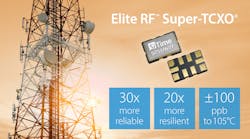Tough TCXOs Boost Bandwidth and Latencies in 5G, Satcom Apps
The Overview
SiTime’s Elite RF Super-TCXOs enable the higher bandwidths and lower latencies critical to modern and future 5G and satellite communications deployments. They’re a new class of MEMS-based, highly integrated temperature-controlled crystal oscillators built to withstand extreme environments.
Who Needs It & Why?
The ongoing densification of 5G and satellite communications means a need for greater bandwidths and lower latencies. That, in turn, means more deployments in extremely harsh environments that engender lots of thermal shock and vibration.
Historically, quartz-based miniature TCXOs have been the go-to devices as timing references in 5G and satcom radios. Such devices provided the stability over changing temperature that was necessary to clock advanced synchronized radios.
However, although they’re accurate, quartz-based TCXOs are notoriously unreliable, especially in harsh environments. Moreover, they consume excessive power and board space and require additional components, such as jitter cleaners and VCXOs for generating RF-capable clocks. One Elite RF Super-TCXO replaces all of these components in 5G small cells, remote radio units, microwave backhaul, and satcom applications.
Under the Hood
Whereas older quartz-based TCXO architectures meet the frequency stability over temperature requirements of 5G systems, they're not only unreliable, but also large in size. That’s due, at least in part, to the fact that they contain a quartz TCXO/OCXO, a digital-to-analog converter (DAC), and a quartz VCXO. The Elite RF Super-TCXOs include all of these components in a package that’s 4X smaller and consumes 3X less power.
Quartz-based TCXOs offer a mean time between failure (MBTF) of between 250,000 and 1 million hours at best. That means you’ll need to replace such devices every two to three years. Elite RF Super-TCXOs are said to be 30X more reliable.
Elite RF Super-TCXO devices offer a frequency range of 1 to 220 MHz with ±100-ppb stability over temperature and a –40 to +105°C operating temperature range. Other key specifications include:
- ±0.9-ppb/°C stability over temperature slope
- ±400-ppm digital control with ±0.05-ppt (parts per trillion) resolution
- 100-fs typical integrated phase jitter (19.2 MHz, 12-kHz to 20-MHz integration range)
- 0.3-ppb/day typical daily aging
- 144-mW power consumption at 1.8 V
- 5.0- × 3.5-mm ceramic package
Limited customer sampling is available now; general sampling will be available in Q2 2023. Mass production is expected in Q3 2023.

